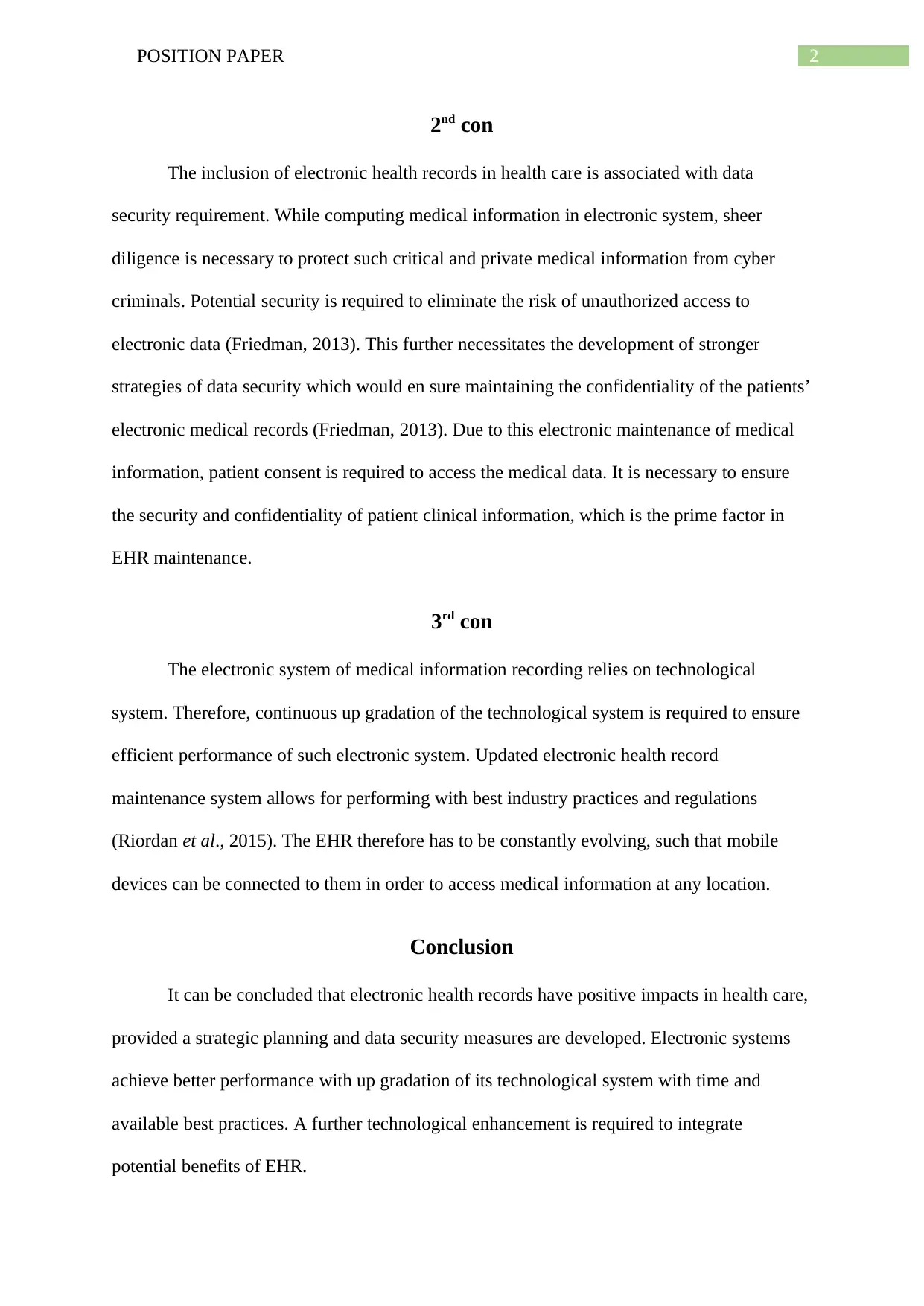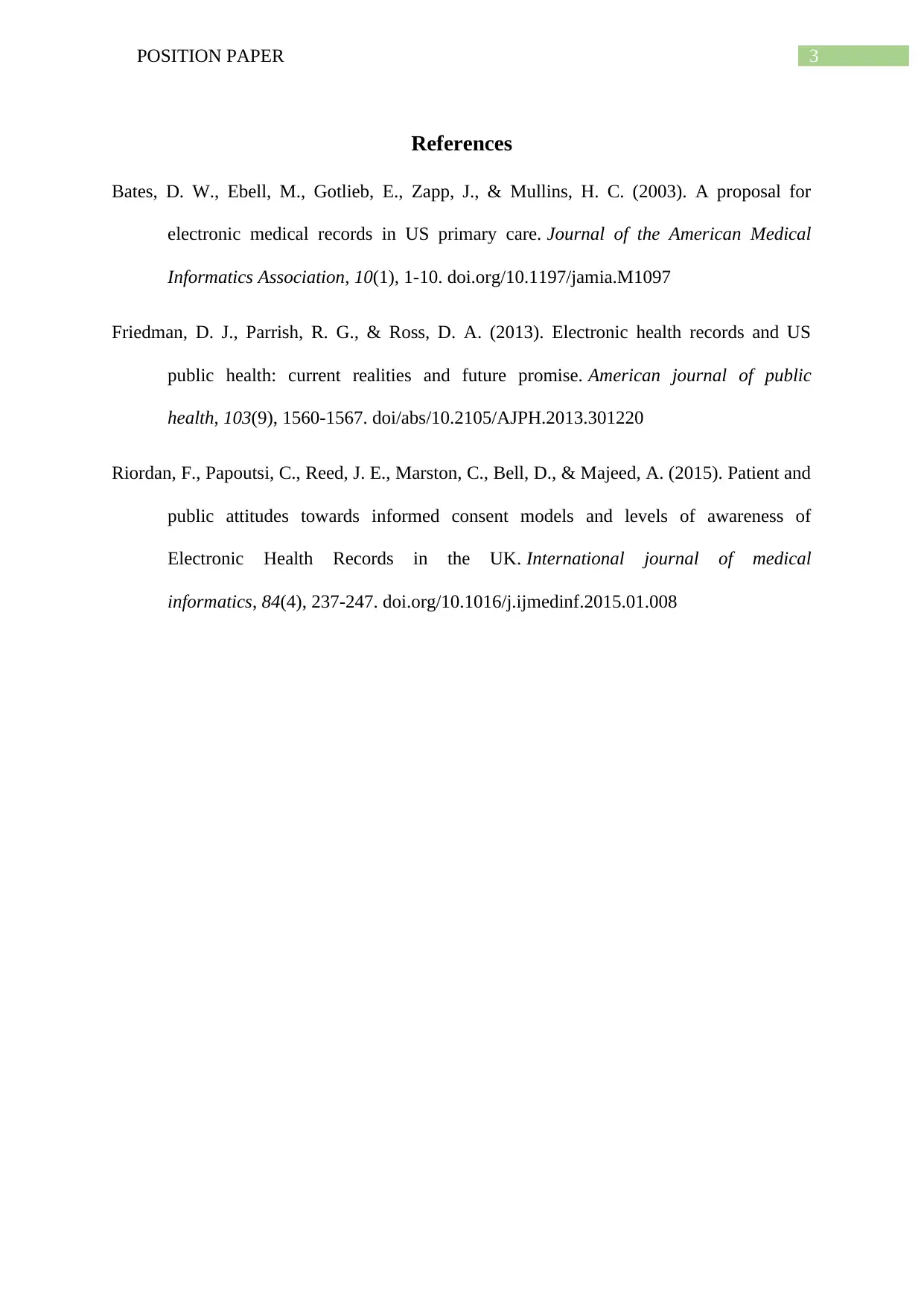EHR Cons: Evaluating Challenges of Electronic Health Records
VerifiedAdded on 2023/04/25
|4
|749
|289
Essay
AI Summary
This essay presents a con position on Electronic Health Records (EHR) in healthcare. It highlights three major challenges: the requirement of computer literacy among healthcare staff and patients, data security concerns related to electronic storage of sensitive medical information, and the need for continuous technological upgrades to maintain efficient EHR systems. The essay argues that while EHRs offer potential benefits, these challenges must be addressed through strategic planning, robust data security measures, and ongoing technological enhancements to fully realize the advantages of EHR implementation.

Running head: POSITION PAPER
Position Paper
Name of student:
Name of university:
Author Note:
Position Paper
Name of student:
Name of university:
Author Note:
Paraphrase This Document
Need a fresh take? Get an instant paraphrase of this document with our AI Paraphraser

1POSITION PAPER
Introduction
The following paper discusses the cons of Electronic Health Record system of
maintaining medical data and develops a con position through a brief review of three cons
that are highlighted in the following. EHR inn health care would achieve desired health care
benefits only when its potential challenges are addressed.
Context
Electronic Health Record system of recording and maintaining medical records of
patients provide a safer as well as transparent method of medical data storage. EHR allows
for easy access to medical data from any location, maintain smooth clinical workflows, and
reduce medical errors that occurred previously due to data maintenance. Although EHR is
utilized into health care with considerable pros, however, several cons of EHR in health care
need to be addressed in order to achieve and utilize the potential benefits of EHR.
1st con
EHR requires knowledge of computer systems and technology to be efficient in EHR
handling. In health care, not all workforce members and even patients are aware of the
technological system of EHR. To gain accurate access to EHR, technological planning and
knowledge are both essential to achieve the potential usefulness of EHR (Bates et al., 2003).
Incorporating only EHR into medical practice would not yield benefits; a strategic planning is
essential to integrate this technological data records into primary care. Inclusion of legal
authority is essential to create an accurate health record. Different groups of health care
members with varying educational qualifications are using EHR; awareness of EHR varies
between different health care members (Bates et al., 2003).
Introduction
The following paper discusses the cons of Electronic Health Record system of
maintaining medical data and develops a con position through a brief review of three cons
that are highlighted in the following. EHR inn health care would achieve desired health care
benefits only when its potential challenges are addressed.
Context
Electronic Health Record system of recording and maintaining medical records of
patients provide a safer as well as transparent method of medical data storage. EHR allows
for easy access to medical data from any location, maintain smooth clinical workflows, and
reduce medical errors that occurred previously due to data maintenance. Although EHR is
utilized into health care with considerable pros, however, several cons of EHR in health care
need to be addressed in order to achieve and utilize the potential benefits of EHR.
1st con
EHR requires knowledge of computer systems and technology to be efficient in EHR
handling. In health care, not all workforce members and even patients are aware of the
technological system of EHR. To gain accurate access to EHR, technological planning and
knowledge are both essential to achieve the potential usefulness of EHR (Bates et al., 2003).
Incorporating only EHR into medical practice would not yield benefits; a strategic planning is
essential to integrate this technological data records into primary care. Inclusion of legal
authority is essential to create an accurate health record. Different groups of health care
members with varying educational qualifications are using EHR; awareness of EHR varies
between different health care members (Bates et al., 2003).

2POSITION PAPER
2nd con
The inclusion of electronic health records in health care is associated with data
security requirement. While computing medical information in electronic system, sheer
diligence is necessary to protect such critical and private medical information from cyber
criminals. Potential security is required to eliminate the risk of unauthorized access to
electronic data (Friedman, 2013). This further necessitates the development of stronger
strategies of data security which would en sure maintaining the confidentiality of the patients’
electronic medical records (Friedman, 2013). Due to this electronic maintenance of medical
information, patient consent is required to access the medical data. It is necessary to ensure
the security and confidentiality of patient clinical information, which is the prime factor in
EHR maintenance.
3rd con
The electronic system of medical information recording relies on technological
system. Therefore, continuous up gradation of the technological system is required to ensure
efficient performance of such electronic system. Updated electronic health record
maintenance system allows for performing with best industry practices and regulations
(Riordan et al., 2015). The EHR therefore has to be constantly evolving, such that mobile
devices can be connected to them in order to access medical information at any location.
Conclusion
It can be concluded that electronic health records have positive impacts in health care,
provided a strategic planning and data security measures are developed. Electronic systems
achieve better performance with up gradation of its technological system with time and
available best practices. A further technological enhancement is required to integrate
potential benefits of EHR.
2nd con
The inclusion of electronic health records in health care is associated with data
security requirement. While computing medical information in electronic system, sheer
diligence is necessary to protect such critical and private medical information from cyber
criminals. Potential security is required to eliminate the risk of unauthorized access to
electronic data (Friedman, 2013). This further necessitates the development of stronger
strategies of data security which would en sure maintaining the confidentiality of the patients’
electronic medical records (Friedman, 2013). Due to this electronic maintenance of medical
information, patient consent is required to access the medical data. It is necessary to ensure
the security and confidentiality of patient clinical information, which is the prime factor in
EHR maintenance.
3rd con
The electronic system of medical information recording relies on technological
system. Therefore, continuous up gradation of the technological system is required to ensure
efficient performance of such electronic system. Updated electronic health record
maintenance system allows for performing with best industry practices and regulations
(Riordan et al., 2015). The EHR therefore has to be constantly evolving, such that mobile
devices can be connected to them in order to access medical information at any location.
Conclusion
It can be concluded that electronic health records have positive impacts in health care,
provided a strategic planning and data security measures are developed. Electronic systems
achieve better performance with up gradation of its technological system with time and
available best practices. A further technological enhancement is required to integrate
potential benefits of EHR.
⊘ This is a preview!⊘
Do you want full access?
Subscribe today to unlock all pages.

Trusted by 1+ million students worldwide

3POSITION PAPER
References
Bates, D. W., Ebell, M., Gotlieb, E., Zapp, J., & Mullins, H. C. (2003). A proposal for
electronic medical records in US primary care. Journal of the American Medical
Informatics Association, 10(1), 1-10. doi.org/10.1197/jamia.M1097
Friedman, D. J., Parrish, R. G., & Ross, D. A. (2013). Electronic health records and US
public health: current realities and future promise. American journal of public
health, 103(9), 1560-1567. doi/abs/10.2105/AJPH.2013.301220
Riordan, F., Papoutsi, C., Reed, J. E., Marston, C., Bell, D., & Majeed, A. (2015). Patient and
public attitudes towards informed consent models and levels of awareness of
Electronic Health Records in the UK. International journal of medical
informatics, 84(4), 237-247. doi.org/10.1016/j.ijmedinf.2015.01.008
References
Bates, D. W., Ebell, M., Gotlieb, E., Zapp, J., & Mullins, H. C. (2003). A proposal for
electronic medical records in US primary care. Journal of the American Medical
Informatics Association, 10(1), 1-10. doi.org/10.1197/jamia.M1097
Friedman, D. J., Parrish, R. G., & Ross, D. A. (2013). Electronic health records and US
public health: current realities and future promise. American journal of public
health, 103(9), 1560-1567. doi/abs/10.2105/AJPH.2013.301220
Riordan, F., Papoutsi, C., Reed, J. E., Marston, C., Bell, D., & Majeed, A. (2015). Patient and
public attitudes towards informed consent models and levels of awareness of
Electronic Health Records in the UK. International journal of medical
informatics, 84(4), 237-247. doi.org/10.1016/j.ijmedinf.2015.01.008
1 out of 4
Related Documents
Your All-in-One AI-Powered Toolkit for Academic Success.
+13062052269
info@desklib.com
Available 24*7 on WhatsApp / Email
![[object Object]](/_next/static/media/star-bottom.7253800d.svg)
Unlock your academic potential
Copyright © 2020–2025 A2Z Services. All Rights Reserved. Developed and managed by ZUCOL.





